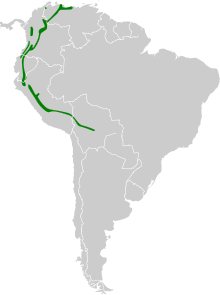Long-tailed sylph
| Long-tailed sylph | |
|---|---|

| |
| Male | |

| |
| Female in Colombia | |
| Scientific classification | |
| Kingdom: | Animalia |
| Phylum: | Chordata |
| Class: | Aves |
| Order: | Apodiformes |
| Family: | Trochilidae |
| Genus: | Aglaiocercus |
| Species: | A. kingii
|
| Binomial name | |
| Aglaiocercus kingii (Lesson, 1832)
| |

| |
The long-tailed sylph (Aglaiocercus kingii) is a species of hummingbird in the family Trochilidae. It is found in Bolivia, Colombia, Ecuador, Peru, and Venezuela. Its natural habitat is subtropical or tropical moist montane forest. It has an average lifespan of 3 to 4 years in the wild.
Diet and feeding[]
The long-tailed sylph feeds on nectar (as of many other hummingbirds), insects, and, at times, small spiders. Flowers with higher sugar content are often preferred. They can be seen at hummingbird feeders, as well. A long-tailed sylph can lick nectar up to 13 times per second!
Courtship strategy[]
The male long-tailed sylph carries characteristic elongated tail feathers. These feathers are so ridiculously long that they hinder his flight: it is difficult for him to carry such finery every day when he relies on his flying skills to survive[citation needed]. Female sylphs, whose tails are of a more modest size, pick out and mate with the males with the longest tail feathers. They therefore ensure that they are mating with a male who is so fit and healthy that he can live well enough to come into breeding condition even when carrying a heavy load.[citation needed] Females do not possess these long tail feathers, as to make laying and incubating eggs easier.
References[]
- ^ BirdLife International (2012). "Aglaiocercus kingii". IUCN Red List of Threatened Species. 2012. Retrieved 26 November 2013.
| Wikimedia Commons has media related to Category:Aglaiocercus kingii. |
- IUCN Red List least concern species
- Aglaiocercus
- Birds of the Northern Andes
- Birds described in 1898
- Apodiformes stubs
